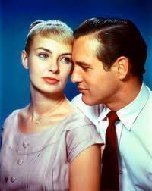A stapler is a mechanical device that joins pages of paper or similar material by driving a thin metal staple through the sheets and folding the ends. Staplers are widely used in government, business, offices, work places, homes and schools.
The word "stapler" can actually refer to a number of different devices of varying uses. In addition to joining paper sheets together, staplers can also be used in a surgical setting to join tissue together with surgical staples to close a surgical wound (much in the same way as sutures).
Most staplers are used to join multiple sheets of paper. Paper staplers come in two distinct types: manual and electric. Manual staplers are normally hand-held, although models that are used while set on a desk or other surface are not uncommon. Electric staplers exist in a variety of different designs and models. Their primary operating function is to join large numbers of paper sheets together in rapid succession. Some electric staplers can join up to 20 sheets at a time. Typical staplers are a third-class lever.
The modern stapler
In 1941 the type of paper stapler that is the most common in use today was developed: the four way paper stapler. With the four way, the operator could either use the stapler to staple papers to wood or cardboard, or used to staple like pliers for bags, or the normal way with the head positioned a small distance above the stapling plate. The stapling plate is known as the anvil. The anvil often has two settings: the first, and by far most common, is the reflexive setting, also known as the "permanent" setting. In this position the legs of the staple are folded toward the center of the cross bar. It is used to staple papers which are not expected to need separation. If rotated 180° or slid to its second position, the anvil will be set on the sheer setting, also known as the "temporary" or "straight" setting. In this position the legs of the staple are folded outwards, away from the cross bar, resulting in the legs and cross bar being in more or less a straight line. Stapling with this setting will result in more-weakly secured papers, but a staple that is much easier to remove. The use of the second setting is almost never seen, however, due to the prevalence of staple removers and the general lack of knowledge about its use. Some simple modern staplers feature a fixed anvil that lacks the sheer position.
Modern staplers continue to evolve and adapt to the changing habits of users. Less-effort, or easy-squeeze/use staplers, for example, make use of different leverage efficiencies to reduce the amount of force the user need apply. As a result, these staplers tend to be used in work environments where repetitive, large stapling jobs are routine.
Some modern desktop staplers make use of Flat Clinch technology. With Flat Clinch staplers, the staple legs first pierce the paper and are then bent over and pressed absolutely flat against the paper – doing away with the two-setting anvil commonly used and making use of a recessed stapling base in which the legs are folded. Accordingly, staples do not have sharper edges exposed and lead to flatter stacking of paper – saving on filing and binder space.
Some photocopiers feature an integrated stapler allowing copies of documents to be automatically stapled as they are printed.
Permanent fastening binds items by driving the staple through the material and into an anvil, a small metal plate that bends the ends, usually inward. On most modern staplers, the anvil rotates or slides to change between bending the staple ends inward for permanent stapling or outward for pinning (see below). Clinches can be standard, squiggled, flat, or rounded completely adjacent to the paper to facilitate neater document stacking.
Pinning temporarily binds documents or other items. To pin, the anvil slides or rotates so that the staple bends outwards instead of inwards. Some staplers pin by bending one leg of the staple inwards and the other outwards. The staple binds the item with relative security, but is easily removed.
Tacking fastens objects to surfaces, such as bulletin boards or walls. A stapler that can tack has a base that folds back out of the way so staples drive directly into an object rather than fold against the anvil. In this position the staples are driven similar to the way a staple gun works, but with less force driving the staple.
Saddle staplers have an inverted V-shaped saddle for stapling pre-fold sheets to make booklets.
Stapleless staplers, invented in 1910, are a means of stapling that punches out a small flap of paper and weaves it through a notch. A more recent alternative method avoids the resulting hole by crimping the pages together with serrated metal teeth instead.
- 6 boneless, skinless chicken breast halves
- 6 slices Swiss cheese (1 ounce each)
- 1/4 pound fresh mushrooms, sliced (optional)
- 1 can (10-3/4 ounces) condensed cream of chicken soup
- 1/2 cup dry white wine
- 2 cups herb-seasoned classic stuffing mix
- 8 tablespoons butter, melted
- Preheat oven to 350º. Coat a 9- x 13-inch baking dish with cooking spray.
- Place chicken in prepared baking dish. Top each piece with a slice of Swiss cheese. Arrange sliced mushrooms over cheese, if desired.
- In a small bowl, mix together soup and wine; pour over chicken. Sprinkle stuffing mix over top, and drizzle on melted butter.
- Bake 35 to 40 minutes, or until chicken is cooked through and no pink remains.
His parents, Brian and Jen, daughter Sami, and grandma Jean all went to Reno for Sami's gymnastics competition. Sami did really well...she was one of three on level 8.
NATIONAL POLAR BEAR DAY HISTORY
Each year, Polar Bears International sponsors National Polar Bear Day. They have been celebrating the day since at least 2011.
Polar Bear FAQ
Q. Are polar bears white?
A. A polar bear’s skin is actually black. Its thick, insulating fur is translucent.
Q. Where do polar bears live?
A. Polar bears cover quite a bit of territory. Their home in the Arctic spans from Russia, across Norway, Greenland, Canada, and some parts of Alaska.
Q. What is a polar bear hybrid?
A. Some polar bears and grizzly bears have bred creating a hybrid bear. They are called various names including grolar and pizzly bears

















2 comments:
Interesting about the range of polar bears.
Never thought of combing white wine with condensed soup.
Excited to hear how Sami’s competition goes.
Lydia
Glad Dash was with you! Know you miss your fur family. ♥️♥️
Post a Comment